Centauri Dreams
Imagining and Planning Interstellar Exploration
WISE 0855: Probing a Brown Dwarf’s Atmosphere
A brown dwarf as a ‘quieter’ version of Jupiter? That’s more or less the picture offered in a new paper on WISE 0855 from Andrew Skemer (UC-Santa Cruz) and colleagues. Here we’re working in the Solar System’s close neighborhood — WISE 0855 is a scant 7.2 light years from Earth — and we’re observing an object that is the coldest known outside of the Solar System. That makes the observational task difficult, but it has yielded rich results in the discovery of clouds of water or water ice.
We learn that WISE 0855 is about five times the mass of Jupiter, with a temperature in the range of 250 K (-23 Celsius). This is the nearest known object of planetary mass, but it is too faint to characterize with conventional spectroscopy — separating light into its component wavelengths — in the optical or near infrared. But it turns out the object can be studied through thermal emissions from deep in its atmosphere in the range of 5 µm (a range frequently used to study Jupiter’s own deep thermal emissions). Skemer calls spectroscopy of such a faint object in this 5 µm ‘window’ “challenging but not impossible.”
And while we have no current space observatories that can perform 5 µm spectroscopy, we can use ground-based instruments working through the 4.5-5.2 µm atmospheric window of our own planet, although the target is a dim object indeed and observations are limited by the brightness of the Earth’s sky. WISE 0855 becomes the faintest object yet detected with ground-based 5 µm spectroscopy, fully five times fainter than the previous such detection.
The observations were performed with the Gemini-North telescope and the Gemini Near Infrared Spectrograph at Mauna Kea, where the infrared background is the lowest for any telescope of its class. Skemer and team observed WISE 0855 over a thirteen night period for a total of about 14 hours. The resulting spectrum reveals the presence of atmospheric water vapor and clouds. The results depict an object with an appearance similar to Jupiter, a place that fits the team’s calculations involving an atmosphere dominated by water vapor.
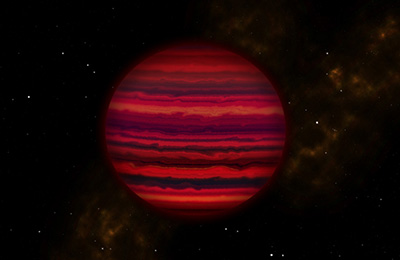
Image: Artist’s rendering of WISE 0855 as it might appear if viewed up close in infrared light. Credit: Joy Pollard, Gemini Observatory/AURA.
The cloud models used here make no assumptions about the composition of cloud being observed, but the paper notes that the temperature of WISE 0855 is such that a composition of water or water ice is likely. Even so, the authors add that the fit of their cloudy model to the observations is not exact, suggesting that there is further complexity here, perhaps involving the vertical and horizontal structure of the clouds, which would affect the brown dwarf’s appearance.
How to move forward from these results? The paper suggests the following:
To understand the nature of clouds and vertical mixing in cold gas giants, we need 5 µm spectra of objects across a continuum of temperatures. After Jupiter (130 K) and WISE 0855 (250 K), the next coldest object with a 5 µm spectrum is Gl 570D (700 K) (Sorahana & Yamamura 2012). In the near term, ground-based telescopes have the sensitivity to obtain spectra of a handful of objects in this temperature range. Future facilities, like the James Webb Space Telescope (JWST), will have the sensitivity to characterize cold gas giants with higher precision, and at wavelengths not possible from Earth (Morley et al. 2014).
As mentioned above, it will be interesting to see what we can learn about Gl 570D, which is a cool brown dwarf about 1500 AU from the triple star system Gl 570, itself composed of a K-class dwarf separated by 190 AU from two red dwarfs that orbit the primary. The brown dwarf here has an estimated mass about 50 times greater than Jupiter and a temperature of about 700 K. The system is approximately 19 light years from Earth.
And we should bear in mind that next-generation Earth-based telescopes (the so-called Extremely Large Telescopes, or ELTs) will have the ability to study large samples of exoplanets in the 5 µm atmospheric window, allowing us to compare not just them but brown dwarfs of various sizes and temperatures with the gas giants here in the Solar System.
Given WISE 0855’s similarities to Jupiter especially regarding the water absorption features in its spectrum, it’s interesting to note the differences. The researchers found that the spectrum of WISE 0855 does not show a strong phosphine (PH3) signal:
If WISE 0855 had Jupiter’s abundance of PH3, it would easily be visible in our spectrum. The fact that WISE 0855 has less PH3 than Jupiter most likely implies that WISE 0855 has less turbulent mixing than Jupiter, although atmospheric metallicity and gravity may also play a role.
So we have a less turbulent atmosphere than Jupiter’s on a cloudy world that probably looks much like the giant planet. We’re probing dynamical and chemical features of an ultra-cool brown dwarf, characteristics we have long studied in our own gas giants. Lacking the mass to spark fusion following the gravitational collapse of the original proto-stellar cloud, WISE 0855 is an ‘almost star’ that may eventually teach us much about the formation of such objects as we expand our range of observations to perform similar studies of gas giant exoplanets.
The paper is Skemer et al., “The First Spectrum of the Coldest Brown Dwarf,” accepted at Astrophysical Journal Letters (preprint). A UC-Santa Cruz news release is available.

Directly Imaged Planet in a Triple Star System
Into the annals of oddball orbits now comes HD 131399Ab, a planet whose wide orbit inside a triple-star system is unlike anything we’ve yet seen. 320 light years from Earth in the constellation Centaurus, this is a gas giant of about four Jupiter masses that was discovered through direct imaging. The discovery was made with the European Southern Observatory’s Very Large Telescope in Chile using the SPHERE (Spectro-Polarimetric High-contrast Exoplanet REsearch) instrument, which exploits differential imaging to screen stellar light from planetary signatures.
HD 131399Ab is the first exoplanet discovered by SPHERE, which incorporates adaptive optics, a coronagraph and, with its differential imaging features, distinguishes a planet by the polarization of reflected light. Stars emit unpolarized light — here the electromagnetic waves oscillate randomly, and in different directions, as explained in this ESO news release. But light reflected from a planetary surface is partially polarized, so that the light waves oscillate in a well-defined plane. Light from the planet is thus much easier to isolate.
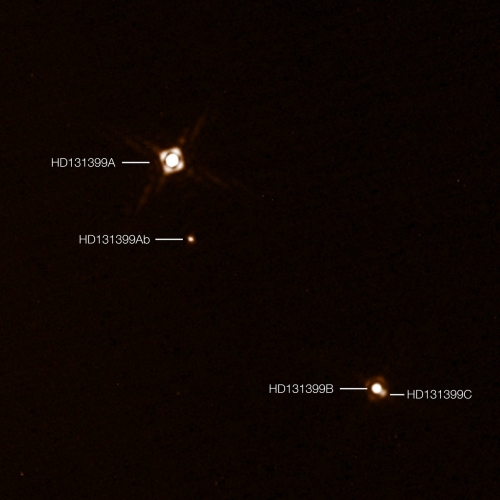
Image: This annotated composite image shows the newly discovered exoplanet HD 131399Ab in the triple-star system HD 131399. The image of the planet was obtained with the SPHERE imager on the ESO Very Large Telescope in Chile. This is the first exoplanet to be discovered by SPHERE and one of very few directly-imaged planets. This picture was created from two separate SPHERE observations: one to image the three stars and one to detect the faint planet. The planet appears vastly brighter in this image than in would in reality in comparison to the stars. Credit: ESO/K. Wagner et al.
And what a planet this is, or more precisely, what an orbit it follows. The brightest star here is HD 131399A, about 80 percent more massive than the Sun. It, in turn, is orbited by HD 131399B and HD 131399C, which are roughly 300 AU from the primary. B and C are separated by about 10 AU, the distance between the Sun and Saturn.
The planet HD 131399Ab orbits HD 131399A at about 80 AU, with an orbital period of 550 years. From the perspective of the planet, all three stars would appear close together for a large part of the year. But as the planet moves along in its orbit, things change. First-year PhD student Kevin Wagner (University of Arizona), lead author of the paper announcing the discovery, explains:
“For about half of the planet’s orbit, which lasts 550 Earth-years, three stars are visible in the sky, the fainter two always much closer together, and changing in apparent separation from the brightest star throughout the year. For much of the planet’s year the stars appear close together, giving it a familiar night-side and day-side with a unique triple-sunset and sunrise each day. As the planet orbits and the stars grow further apart each day, they reach a point where the setting of one coincides with the rising of the other – at which point the planet is in near-constant daytime for about one-quarter of its orbit, or roughly 140 Earth-years.”
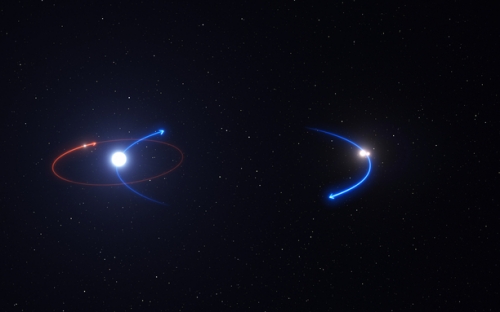
Image: This graphic shows the orbit of the planet in the HD 131399 system (red line) and the orbits of the stars (blue lines). (Credit: ESO).
This is an orbit whose stability would be tenuous. In fact, the question of long-term stability cannot be decided without further observations to constrain the planet’s orbit. Says Daniel Apai (University of Arizona), one of the co-authors of the paper on this work:
“If the planet were further away from the most massive star in the system, it would be kicked out of the system. Our computer simulations have shown that this type of orbit can be stable, but if you change things around just a little bit, it can become unstable very quickly.”
The ESO animation below puts the system in motion.
Image: This artists impression shows the orbit of the planet in the triple-star system HD 131399. Two of the stars are close together and the third, brighter component is orbited by the gas giant planet HD 131399Ab. Credit: ESO/L. Calçada/M. Kornmesser.
Consider all the factors at work here: We have a planet on the widest known orbit within a multi-star system, a situation that is dynamically unique. HD 131399Ab is one of the lowest mass planets yet imaged directly, and also one of the coldest, at approximately 850 Kelvin. And at about 16 million years old, it is also one of the youngest exoplanets we’ve found. Remember that multi-star systems are about as common as single stars, giving us an idea of the variety we’re likely to find and its significance as we analyze scenarios for planet formation.
The paper is Wagner et al., “Direct Imaging Discovery of a Jovian Exoplanet Within a Triple Star System,” Science 7 July 2016 (abstract).

Prebiotic Chemistry on Titan?
If you’re looking for liquid water on Titan, prepare to go deep, perhaps as much as 100 kilometers below the Saturnian moon’s crust, which is itself made of ice. When it comes to exoplanets, we always talk about the habitable zone as a place where liquid water could exist on the surface. Titan clearly fails that test. But is it a place where life could exist anyway?
A new paper gets us into this interesting topic by suggesting that prebiotic chemistry — and possibly even biochemistry — could take place on Titan. The work of Martin Rahm and Jonathan Lunine, working with colleagues David Usher and David Shalloway (all at Cornell University), the study sees Titan as a ‘natural laboratory’ for exploring non-terrestrial prebiotic chemistry given the presence of liquid hydrocarbons and the lack of liquid surface water.

Image: An image of Titan’s surface, as taken by the European Space Agency’s Huygens probe as it plunged through the moon’s thick, orange-brown atmosphere on Jan. 14, 2005. Today, Cornell scientists have chemical evidence that suggests prebiotic conditions may exist there. Credit: ESA/NASA/JPL-Caltech/Univ. of Arizona.
We are in the realm of prebiotic chemistry in an exceedingly alien environment. Says Rahm:
“We are used to our own conditions here on Earth. Our scientific experience is at room temperature and ambient conditions. Titan is a completely different beast. So if we think in biological terms, we’re probably going to be at a dead end.”
Titan’s rivers, lakes and seas have captivated us since the Huygens probe gave us our first glimpse beneath the clouds, and we know that they are filled with liquid methane and ethane flowing beneath a dense atmosphere of nitrogen and methane. Chemistry here is driven by solar photons that produce hydrocarbons and nitrogen-bearing organics. The Cassini mission has shown us that hydrogen cyanide (HCN) is the most abundant nitrogen-bearing product resulting from this atmospheric chemistry, condensing into aerosols that, upon reaching the surface, are evidently transformed into other molecules and polymers (chemical compounds where molecules are bonded together in long, repeating chains).
One of the polymers that may emerge from hydrogen cyanide’s reactions with other molecules is polyimine (pronounced poly-ee-meen), which is flexible even under the low temperatures found on Titan. The paper analyzes the properties of polyimine (pI) and finds that even in these conditions, it can absorb solar energy and become a factor in possible life:
Regardless of the specific chemistry involved, life requires polymorphic molecules that combine flexibility with the ability to form the organized metastable structures needed for function, adaptation, and evolution. This, almost certainly, requires extended molecules capable of intermolecular and intramolecular hydrogen bonding, but such bonds need not involve oxygen; nitrogen is a potential surrogate.
The polymorphism of polyimine compounds could be the key to prebiotic chemistry in the cryogenic conditions of Titan. The authors’ work on pI shows that complex, ordered structures can emerge. Moreover, polyimine is found to be able to absorb a wide range of photons through a relatively transparent ‘window’ in Titan’s atmosphere, thus having a source of energy at its disposal to catalyze prebiotic chemistry even without the presence of water.
But the larger seas that are so striking in Cassini imagery are not necessarily where it would first emerge. These are mostly methane, with significant amounts of ethane and nitrogen. Hydrogen cyanide is mostly insoluble in such mixtures, making it unlikely that polymers would form there. The paper argues that we’re more likely to find hydrogen cyanide undergoing reactions in tidal pools near the shores of the seas and lakes, where the environment is dynamic because of tidal effects (Titan’s orbit is non-circular), and hemispherical variations in sunlight:
Seasonal emptying and refilling of the smaller liquid “lakes,” such as Ontario Lacus in the Southern Hemisphere, and longer-timescale variations in sea levels associated with Saturn’s orbital variations, may allow cycling of these materials between liquid and dry (shoreline) environments, where they would be well positioned to undergo further chemistry.
We learn that possible prerequisites for life do exist on Titan, but what lies ahead is a deeper understanding of how this chemistry evolves. In terms of possible future missions, remote sensing here gives way to the need for direct chemical analysis on the surface, doubtless through a lander sent to shoreline areas of the lakes and seas. As the paper notes, “…only future exploratory missions to Titan can test the hypothesis that natural chemical systems evolve chemical complexity in almost any circumstance.”
The paper is Rahm et al., “Polymorphism and electronic structure of polyimine and its potential significance for prebiotic chemistry on Titan,” published online by Proceedings of the National Academy of Sciences 4 July 2016 (abstract). Thanks to Phil Tynan for an early tip on this work.

Operations Throughout the Solar System
A reminder of how challenging it is to operate with solar power beyond the inner system is the fact that Juno carries 18,698 individual solar cells. Because it is five times further from the Sun than the Earth, the sunlight that reaches Juno is 25 times less powerful, a reflection of the fact that the intensity of light is inversely proportional to the square of the distance from the source.
In other words, if you’re going to use solar power this far out from the Sun, you’d better have plenty of surface area. Juno carries three 9-meter solar arrays that could, at Earth’s distance of 1 AU, generate as much as 14 kilowatts of electricity. But at Jupiter’s distance, controllers are expecting a realistic output of about 500 watts. Making solar power operations possible here is improved solar cell performance and a mission plan that avoids Jupiter’s shadow.
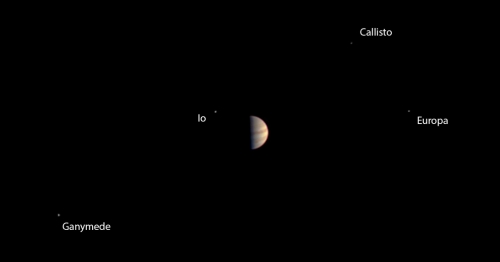
Image: This is the final view taken by the JunoCam instrument on NASA’s Juno spacecraft before Juno’s instruments were powered down in preparation for orbit insertion. Juno obtained this color view on June 29, 2016, at a distance of 5.3 million kilometers from Jupiter. Credit: NASA/JPL-Caltech/SwRI/MSSS.
Planning Rosetta’s Finale
The European Space Agency’s Rosetta mission is coping with the same issue. Rosetta will end its mission to Comet 67P/Churyumov-Gerasimenko on 30 September with a controlled descent to the surface. The increasing distance between the Sun and the comet alongside which Rosetta travels means that its own solar power will be insufficient to operate its instruments or downlink data. Thus Rosetta is destined to join the Philae lander on the comet’s surface.
“We’re trying to squeeze as many observations in as possible before we run out of solar power,” says Matt Taylor, ESA Rosetta project scientist. “30 September will mark the end of spacecraft operations, but the beginning of the phase where the full focus of the teams will be on science. That is what the Rosetta mission was launched for and we have years of work ahead of us, thoroughly analysing its data.”
Controllers will use much of August to adjust Rosetta’s trajectory, inducing a series of elliptical orbits that will progressively close on the comet. A trajectory change about twelve hours before impact will put the spacecraft on course for final descent. Rosetta will touch down at about half the speed of Philae, but there will be no possibility of communications from the orbiter once it reaches the surface because the high gain antenna will probably not be pointing toward Earth. Even so, we should get some spectacular images at high resolution during the descent.
This ESA news release has more, including mention of the fact that Rosetta entered safe mode last month when about five kilometers from the comet due to dust-related navigation system issues. While the spacecraft recovered, the glitch bears witness to how challenging operations this close to a comet can be. Bringing Rosetta down to the surface may create similar problems.
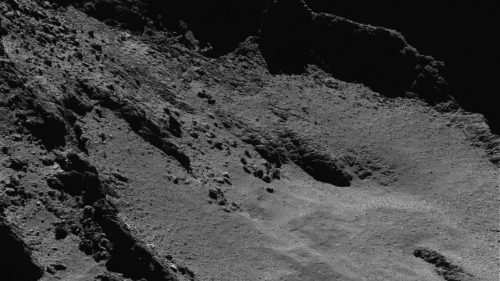
Image: During Rosetta’s final descent, the spacecraft will image the comet’s surface in high resolution from just a few hundred metres. This OSIRIS narrow-angle camera image was taken on 28 May 2016, when the spacecraft was about 5 km from the surface of Comet 67P/Churyumov-Gerasimenko. The scale is 0.13 m/pixel. Credit: ESA/Rosetta/MPS for OSIRIS Team MPS/UPD/LAM/IAA/SSO/INTA/UPM/DASP/IDA.
Dawn at Ceres
The Dawn spacecraft has been slotted to remain at Ceres rather than proceed on to the main belt asteroid Adeona. What this means is that we’ll be able to stay close to Ceres while the dwarf planet approaches perihelion, an interesting place to be given the many unanswered questions about this world and its unusual bright spots. A new study published in Nature finds that Ceres’ Occator Crater has the highest concentration of carbonate minerals ever seen outside the Earth.
The primary mineral in the brightest area of Occator is found to be sodium carbonate, the upwelling of which is suggestive of warmer conditions inside Ceres than previously believed. Thus we have an intriguing hint of liquid water in comparatively recent geological time, with the salts as possible remnants of a large internal body of water. Says Maria Cristina De Sanctis (National Institute of Astrophysics, Rome), lead author of the paper on this work:
“The minerals we have found at the Occator central bright area require alteration by water. Carbonates support the idea that Ceres had interior hydrothermal activity, which pushed these materials to the surface within Occator.”
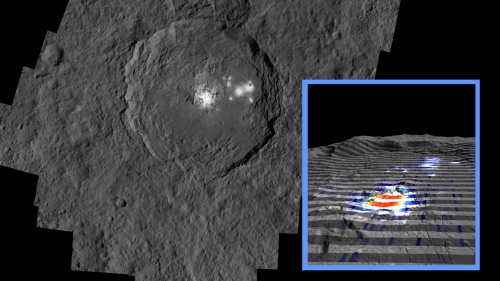
Image: The center of Ceres’ mysterious Occator Crater is the brightest area on the dwarf planet. The inset perspective view is overlaid with data concerning the composition of this feature: Red signifies a high abundance of carbonates, while gray indicates a low carbonate abundance. Dawn’s visible and infrared mapping spectrometer (VIR) was used to examine the composition of the bright material in the center of Occator. Using VIR data, researchers found that the dominant constituent of this bright area is sodium carbonate, a kind of salt found on Earth in hydrothermal environments. Scientists determined that Occator represents the highest concentration of carbonate minerals ever seen outside Earth. Credit: NASA/JPL-Caltech/UCLA/MPS/DLR/IDA.
The paper is De Sanctis et al., “Bright carbonate deposits as evidence of aqueous alteration on (1) Ceres,” published online by Nature 29 June 2016 (abstract).
On to the Kuiper Belt
New Horizons, has been given the go-ahead for an extended mission, which includes a flyby of the Kuiper Belt object 2014 MU69. Although many of us have been taking an extended mission for granted given New Horizons’ unprecedented success, the confirmation brings a sense of relief. The flyby is to take place on January 1, 2019, offering us the chance to look at the kind of ancient object considered to be a building block of the Solar System. As we look ahead, we still have a wealth of data from the Pluto/Charon encounter to receive and analyze.

Arrival: Juno in Orbit
People in the space business always joke about the stress levels at any launch, but if you’re keeping tabs on a billion dollar spacecraft like Juno, I’d say the arrival can create just as many, if not more, gray hairs. Plenty of people are breathing easier this morning after Juno’s successful 35-minute engine burn and entry into orbit around Jupiter, confirmation of which came in just before midnight Eastern US time (03:53 UTC on July 5). Congratulations to the entire team.
All of this was part of a sequence of arrival events — Juno’s orbit-insertion phase (JOI) — that included spinning up the spacecraft from 2 to 5 revolutions per minute as an aid to stability, along with attitude changes in anticipation of the main engine burn, which began at 23:18 EDT. The latter decreased the spacecraft’s velocity by 542 meters per second to make orbital capture possible. Juno has already been turned again to allow its solar cells to work at full capacity.
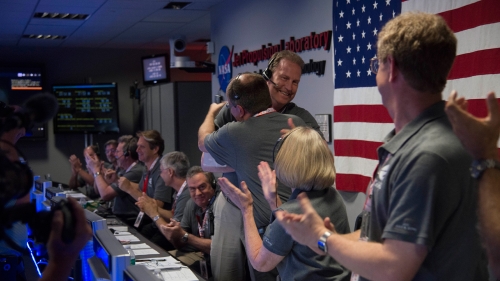
Image: The Juno team celebrates at NASA’s Jet Propulsion Laboratory in Pasadena, California, after receiving data indicating that NASA’s Juno mission entered orbit around Jupiter. Rick Nybakken, Juno project manager at JPL, is seen at the center hugging JPL’s acting director for solar system exploration, Richard Cook. Credit: NASA/JPL-Caltech.
I always love control room photos when things are going well, remembering especially the New Horizons team last summer, images of which mingled joy with astonishment at what the doughty spacecraft was seeing. Juno is now in a 53.5 day orbit in preparation for an eventual 14-day orbit that will be achieved after a final engine burn on October 19. It’s at that point that the mission’s primary science collection period begins.
In this Cornell University news release, Jonathan Lunine, a member of the university’s Carl Sagan Institute, likens Juno’s work at Jupiter to an older discipline here on Earth, one that can help us understand the earliest days of the Solar System. What sort of materials, for example, did Jupiter take in as it grew into the gravitational behemoth it is today?:
[Jupiter is] a unique record for the outer solar system of what these protoplanets might have been like. We’re doing the astronomical equivalent of ‘broken pottery’ archaeology, trying to piece back together the original molecules and ice grains that got evaporated and dissociated inside Jupiter billions of years ago.”
We’ll have the opportunity to look at Jupiter in a number of new ways. The Galileo probe was unable, for example, to measure the water abundance in Jupiter beneath the clouds, but Juno’s microwave radiometer should be able to provide that measurement. Water abundance, in turn, tells us something about the materials that Jupiter absorbed early in its life, And by extension, we can apply this knowledge to the numerous gas giants we’re finding around other stars.
But it’s also going to be fascinating to learn whether or not the giant planet has a solid core. Juno’s gravity experiment will bring the spacecraft to within a few thousand kilometers of the cloud tops, allowing a measurement of the gravity field accurate enough to make the call. Bear in mind that the Cassini probe will burn up in Saturn’s atmosphere in 2017. During its final close flybys inside the rings, the same gravity experiment can be run. Says Lunine:
“[Cassini] will be passing just above the cloud tops like Juno does at Jupiter, underneath the rings of the planet, which will be pretty spectacular. The chance to be able to measure the core for both Jupiter and Saturn is really a tremendous opportunity.”
Bear in mind that even before Juno got to Jupiter, a number of science operations were already in progress, including work with the Jupiter Energetic Particle Detector Instrument (JEDI) to investigate the interplanetary medium as the spacecraft approached. Based at the Johns Hopkins University Applied Physics Laboratory, the JEDI team has been looking at ‘upstream ions,’ as explained by Dennis Haggerty, APL’s instrument scientist for the JEDI investigation:
“Jupiter is a very leaky planet. It has a unique particle identity, especially in terms of sulfur — which is not found in high numbers in the solar wind — and we’ve seen particles from Jupiter ‘upstream’ of the planet from missions including Voyager, Galileo and New Horizons.”
More in this APL news release, which describes the JEDI instrument and its upcoming work on Jupiter’s aurorae, which have a power density ten times greater than Earth’s, and an overall power that is greater by a factor of 100. JEDI will help explain how this system is energized.
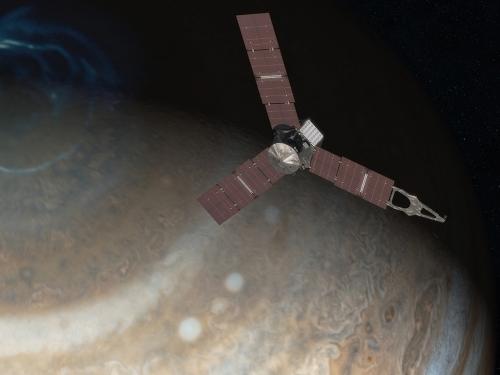
Image: This artist’s concept depicts NASA’s Juno spacecraft above Jupiter’s north pole. Launched in 2011, the Juno spacecraft will arrive at Jupiter on July 4, 2016. As part of its instrument suites, it carries three Johns Hopkins APL-built Jupiter Energetic Particle Detector Instrument (JEDI) units to study the giant planet from an elliptical, polar orbit. Juno will repeatedly dive between the planet and its intense belts of charged particle radiation, coming only 5,000 kilometers (about 3,000 miles) from the cloud tops at closest approach. Juno’s primary goal is to improve our understanding of Jupiter’s formation and evolution. Credit: NASA/JPL-Caltech.
What Lies Beneath
Juno invariably calls up memories of Arthur C. Clarke’s A Meeting with Medusa, a 1971 novella that Greg Benford mentioned in a conversation this past weekend. It’s been many years since I’ve read it, but I may have to revisit the work now that Alastair Reynolds and Stephen Baxter have produced a sequel, a timely arrival given the Juno activities. The Medusa Chronicles evidently presents Clarke’s character Howard Falcon with a host of new challenges, but I’ll want to refresh my memory of the Clarke before tackling it.
In Clarke’s tale, Falcon skippers a balloon craft making a slow descent through Jupiter’s upper atmosphere, where he runs into enormous life-forms, one the Medusa of the title. And here we go back to another Cornell physicist who changed our view of Jupiter, Edwin Salpeter. I’ll send you to Larry Klaes’ fine 2009 essay Edwin Salpeter and the Gasbags of Jupiter for a more detailed look, but I do want to at least mention Salpeter’s work with Carl Sagan on life in the atmospheres of gas giants on the morning of the Juno arrival.

The duo produced a paper titled “Particles, Environments, and Possible Ecologies in the Jovian Atmosphere” that appeared in The Astrophysical Journal in late 1975. Sagan would go on to discuss such life-forms in the popular TV series Cosmos. Let me quote Larry on the kinds of life Sagan and Salpeter imagined:
Sagan and Salpeter envisioned three main types of Jovian creatures. There were sinkers, small organisms which were constantly falling towards the deadly deep, dense, and hot layers of the planet but always managed to survive long enough to produce offspring that would stay up in the more habitable air layers to repeat their cycle of life. The other aerial residents of Jupiter were known as floaters, which Sagan would later describe as being “kilometers across, enormously larger than the greatest whale that ever was, beings the size of cities.” Floaters were seen as drifting across the vast alien sky in great herds, looking like a collection of immense balloons, which in essence there were, using the lighter elements of Jupiter’s atmosphere to stay aloft.
Image: Physicist Edwin Salpeter, whose work with Carl Sagan brought the idea of airborne life in Jupiter’s clouds to a wide audience.
Throw a class of hunter species into the mix and you have a vibrant and violent ecology, one that, the paper pointed out, could have been detected by the Voyager probes’ cameras if a floater of this sort existed and were high enough up in the cloud deck to be seen. Presumably Juno’s views will be spectacularly better, so perhaps some scrutiny of its imagery in search of unusual moving objects could be advocated. In any case, it’s a shame that Clarke, Sagan and Salpeter couldn’t be here to witness Juno’s arrival and the abundant imagery to follow of a realm they once imagined so vividly.

Interstellar Comparisons
No one thinks big better than Adam Crowl, a Centauri Dreams regular and mainstay of the Icarus Interstellar attempt to reconfigure the Project Daedalus starship design of the 1970’s. If you’re looking for ideas for science fiction stories, you’ll find them in the essay below, where Adam considers the uses to which we might put the abundant energies of the Sun. Starships are a given, but what about terraforming not just one but many Solar System objects? Can we imagine a distant future when our own Moon is awash with seas, and snow is falling on a Venus in the process of transformation? To keep up with Adam, be sure to check his Crowlspace site regularly. It’s where I found an earlier version of this now updated and revised essay.
By Adam Crowl

By 2025 Elon Musk believes SpaceX can get us to Mars – a journey of about 500 million kilometres, needing a speed of over 100,000 km/h. By comparison travelling to the stars within a human lifetime via the known laws of physics requires energies millions of times more potent than that budget-price trip to Mars. In our energy hungry modern world the prospect seems fanciful, yet we are surrounded by energies and forces of comparable scale. By taming those forces we will be able to launch forth towards the stars, save our civilization and extend the reach of our biosphere.
How so? Consider the sunlight received every second by planet Earth, from the Sun. About 1.4 kilowatts of energy for every square metre directly facing the Sun – all 128 trillion of them – means a total power supply of 175,000 trillion watts (175 petawatts). That’s 8,750 times more than the mere 20 terawatts human beings presently use. Earth itself receives a tiny fraction of the total available – the Sun radiates about 2.2 billion times more, a colossal 385 trillion trillion watts (385 yottawatts).
Just how much does a starship need?
Project Daedalus proposed a fusion propelled star-probe able to fly to nearby stars in 50 years. To do so it would fuse 50,000 tonnes of deuterium and helium-3, expelling them as a rocket exhaust with an effective jet speed of 10,000 km/s. A total useful energy of 2500 million trillion joules (2.5 zettajoules) – the actual fusion energy available in the fuel was about 10 times this, due to the inefficiency of the fusion rocket motor. However that gives us a useful benchmark. Though vast, this is dwarfed by the energy from the Sun. A full Daedalus fuel-tank is equivalent to just 4 hours of sunlight received by planet Earth.
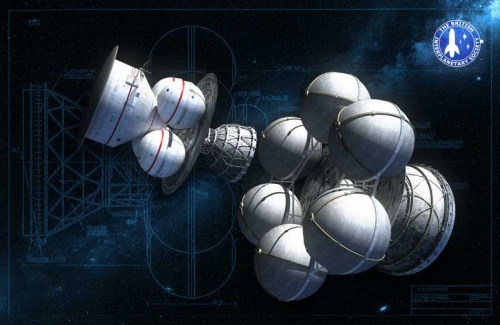
Image: The Daedalus starship, as envisioned by Adrian Mann.
Another design, the Laser-Sail, masses 2,500 metric tons and requires a laser power of 5 petawatts, to accelerate the Laser-Sail starship at 1 gee for 190 days to a cruise speed of half light-speed or 150,000 km/s. A laser-power equal to what Earth intercepts from the Sun, 175 petawatts, could launch ~67 Laser-Sail starships per year. Total energy required per sail is 8.24 yottajoules, equal to 5.45 days of Earth-sunlight.
What else could we do with power supplies that can launch starships? Power on the scale of Worlds (i.e. One Earth = 175 petawatts) allows the remaking of Worlds. Terraforming is the shaping of the dead worlds of the Solar System into more life-friendly environments. Mars, for example, is considered to be the most life-friendly nearby planet other than Earth, yet it lacks an oxygen atmosphere, a significant magnetic field, and is colder than Antarctica. To release Earth-levels of oxygen from its rocks, power an artificial magnetosphere to deflect away the potentially harmful solar-wind, add nitrogen to reduce the fire risk, and keep the planet warm, the energies required are similar to those required to launch starships.
Releasing oxygen from Martian rocks requires melting the rock, usually composed of about 30% oxygen, and breaking the chemical bonds – a process called pyrolysis. What results is a melt of mixed metals, like iron, and semi-metals, like silicon, and oxygen gas, plus some unmelted refractory compounds like aluminum oxide. For every kilogram of oxygen released, about 30 megajoules of energy is needed. Earth-normal oxygen levels require a partial pressure of 20 kilopascals (20 kPa), which means a mass of 5.4 tons of oxygen for every square metre of Martian surface – 775 trillion tons in total. The total energy required is 10 yottajoules.
Adding 80 kPa of nitrogen, like Earth’s atmosphere, requires mining the frozen nitrogen of Neptune’s moon Triton, doubling the total energy required. Pluto’s vast plains of convecting nitrogen ice may provide another possible source, though without the handy proximity of a big planet’s gravity well for getting a boost towards the Sun it might prove uneconomical in energy terms. Shipping it from Saturn’s moon Titan, as Kim Stanley Robinson imagines in his ‘Mars Trilogy’, requires 8 times the energy of using Triton as a source, due to Saturn’s less favourable gravity conditions.
Warming Mars to Earth-like levels, via collecting more solar energy with a vast solar mirror array, means collecting and directing about 50 petawatts of solar energy (equal to about 10 Laser-Sail starships). Before we use that energy to gently warm Mars, it can be concentrated via a “lens” into a solar-torch able to pyrolyse oxygen out of Mars’s rocks. With 50 petawatts of useful energy the lens can liberate sufficient oxygen for breathing in a bit over 6 years.
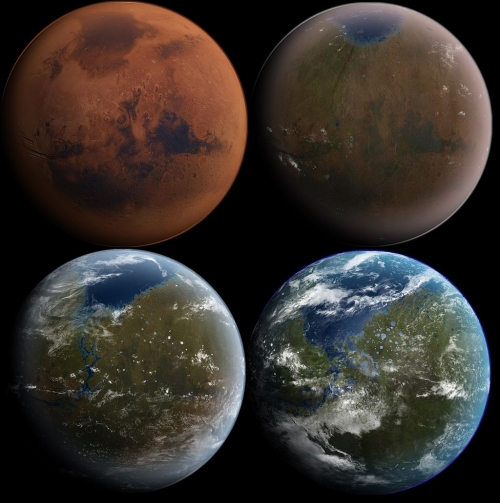
Image: A blue and green Mars emerges from terraforming. Credit: Daein Ballard – The original image was uploaded on en.wikipedia as en:Image:MarsTransitionV.jpg, CC BY-SA 3.0, https://commons.wikimedia.org/w/index.php?curid=939978
The final task, creating an artificial magnetosphere, is puny by comparison. A superconducting magnetic loop, wrapped around the Martian equator, can be used, powered up to a magnetic field energy of ~620,000 trillion joules (620 petajoules), by about 12.4 seconds of energy from the solar-mirrors. This is sufficient to create a magnetosphere about 8 times the size of Mars, much like Earth’s.
Total one-time energy budget is 20 yottajoules – 8,000 “Daedalus” starprobes, or 243 laser-sail starships equivalent. The ongoing power-supply of 50 petawatts is enough to propel 10 Laser-Sail starships at a time.
To terraform the other suitable planets and moons of the Solar System requires similar energy and power levels. For example, if we used a solar-torch to break up the surface ice of Jupiter’s moon, Europa, into hydrogen and oxygen, then used it to ‘encourage’ the excess hydrogen to escape into space, the total energy would be about 8 yottajoules, surprisingly similar to what Mars requires. The nitrogen delivery cost is about 6 yottajoules, again similar to Mars. Ongoing energy supply would be 10 petawatts – two starships worth.
A less exotic location to terraform would be Earth’s Moon. One advantage, as well as proximity to Earth, is no extra input of energy from the Sun is needed to stay warm. However, unlike Europa or Mars, water as well as atmosphere needs to be delivered, multiplying the energy required. If shallow seas are sufficient – an average of 100 metres of water over the whole surface – the energy to deliver ice and nitrogen from Triton, then make oxygen from lunar rocks, is 27 yottajoules.
The only solid planet with close to Earth gravity is Venus. To remake Venus is a vastly more challenging task, as it has three main features that make it un-Earthly: too much atmosphere, too much day-time and not enough water. Take away the atmosphere and the planet would cool rapidly, so while it is often likened to Hell, the comparison is temporary. The energy required to remove 1 kilogram from Venus to infinity is 53.7 megajoules. Venus has over a thousand tons of atmosphere for every square metre of surface – some 467,000 trillion tons of which is carbon dioxide. To remove it all requires 25,600 yottajoules, thus removal is far from being an economical option, even in a future age when yottajoule energy budgets are commonplace.
Another option is to freeze the atmosphere by shading the planet totally. To do so would require placing a vast shade in an orbit between Venus and the Sun, about a million kilometres closer. In this position, the gravity of the Sun and Venus are balanced, allowing the shade to stay fixed in the sky of Venus. With a diameter about twice Venus’s 12,100 kilometres, an endless night produced by the shade would allow Venus to cool down over a period of decades. Eventually the carbon dioxide would rain, then snow, covering the planet in dry-ice. Some form of insulation (foamed rock?) would then be spread over the carbon dioxide to keep it from bursting forth as gas again.
Alternatively it might be pumped into natural cavities, once the sub-surface of Venus is better mapped. The energy cost of assembling such a vast shade, which would mass thousands of tonnes at least, would be far less than the cost of removing the carbon dioxide. So close to the Sun, the shade would intercept the equivalent of 8 times what Earth receives from the Sun – 1,400 petawatts in total, sufficient to propel 280 Laser-Sail starships, or power the terraforming of the other planets. Or both.
The next desirable for Venus is the addition of water. If 100 metres depth is required the total energy to ship it from Triton is 144 yottajoules. Using 50 petawatts of power, the time to export the water is about 122 years, with a 30 year travel time for ice falling Sunwards from Neptune. The total energy of creating an artificial magnetosphere similar in size to Earth’s would be 6 exajoules (6 million trillion joules) – a tiny fraction of the energy budget.

Image: Venus as seen by the Japanese Akatsuki orbiter. The planet was captured in infrared light, showing a surprising amount of atmospheric structure on its night side. The vertical orange terminator stripe between night and day is so wide because of light diffused by Venus’ thick atmosphere. Can we use the Sun’s abundant energies one day to transform this world into a home for life? Credit: ISAS/JAXA.
Further afield than the Inner System and the Outer Planets (including IX, X, XI…) is the Oort Cloud, a spherical swarm of comets thousand to ten thousand times the Earth-Sun distance. According to current planet formation theories there were once thousands of objects, ranging in size from Pluto to Earth’s Moon, which formed out of the primordial disk of gas and dust surrounding the infant Sun. Most coalesced via collisions to form the cores of the big planets, but a significant fraction were slung outwards by gravitational interactions with their bigger siblings, into orbits far from the Sun. One estimate by astronomer Louis Strigari and colleagues hints at 100,000 such objects for every star.
The technology to send a laser beam to a starship accelerating to half light-speed over thousands of Earth-Sun distances opens up that vast new territory we’re only just beginning to discover. A laser able to send 5 petawatts to a Laser-Sail at 1,000 times the Earth-Sun distance, would be able to warm a Pluto-sized planet to Earth-like temperatures at a distance of a light-year. Powering starships will thus enable the spread of the Earth’s biosphere to thousands of worlds which would otherwise remain lifeless. Life on Earth spread out in abundance, aeons ago, once it learnt the trick of harnessing the Sun’s energy via photosynthesis to make food from lifeless chemicals. Bare new volcanic islands are quickly colonised by living things, thanks to the power of the Sun. Humankind can do the same, but on a vastly greater scale – it’s the natural thing to do.


